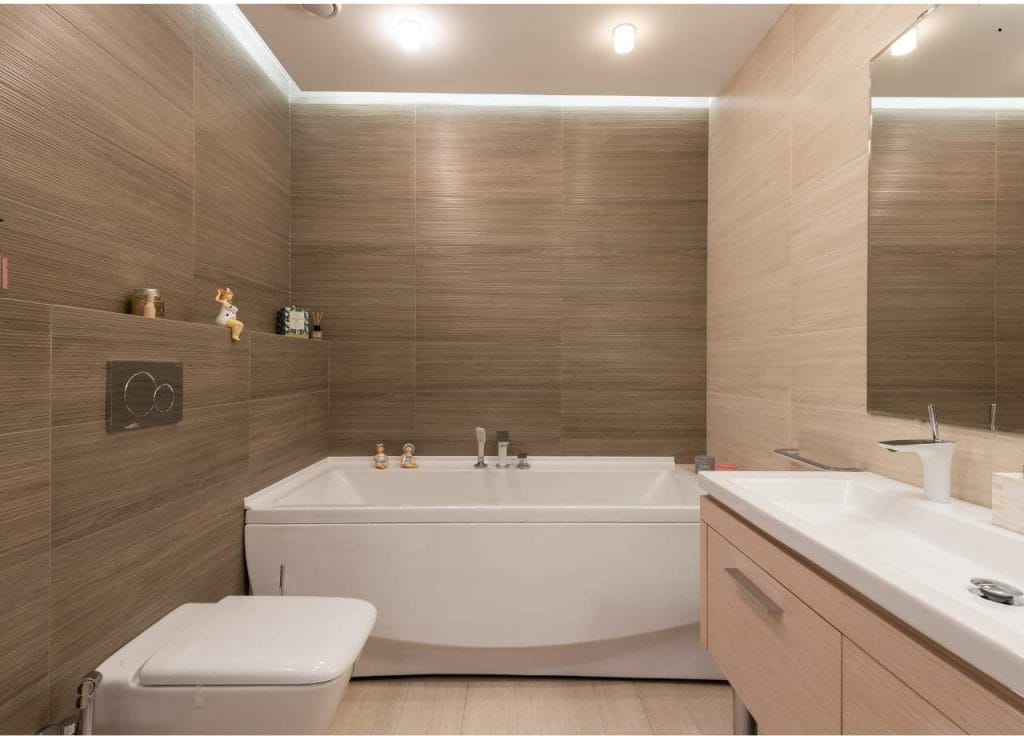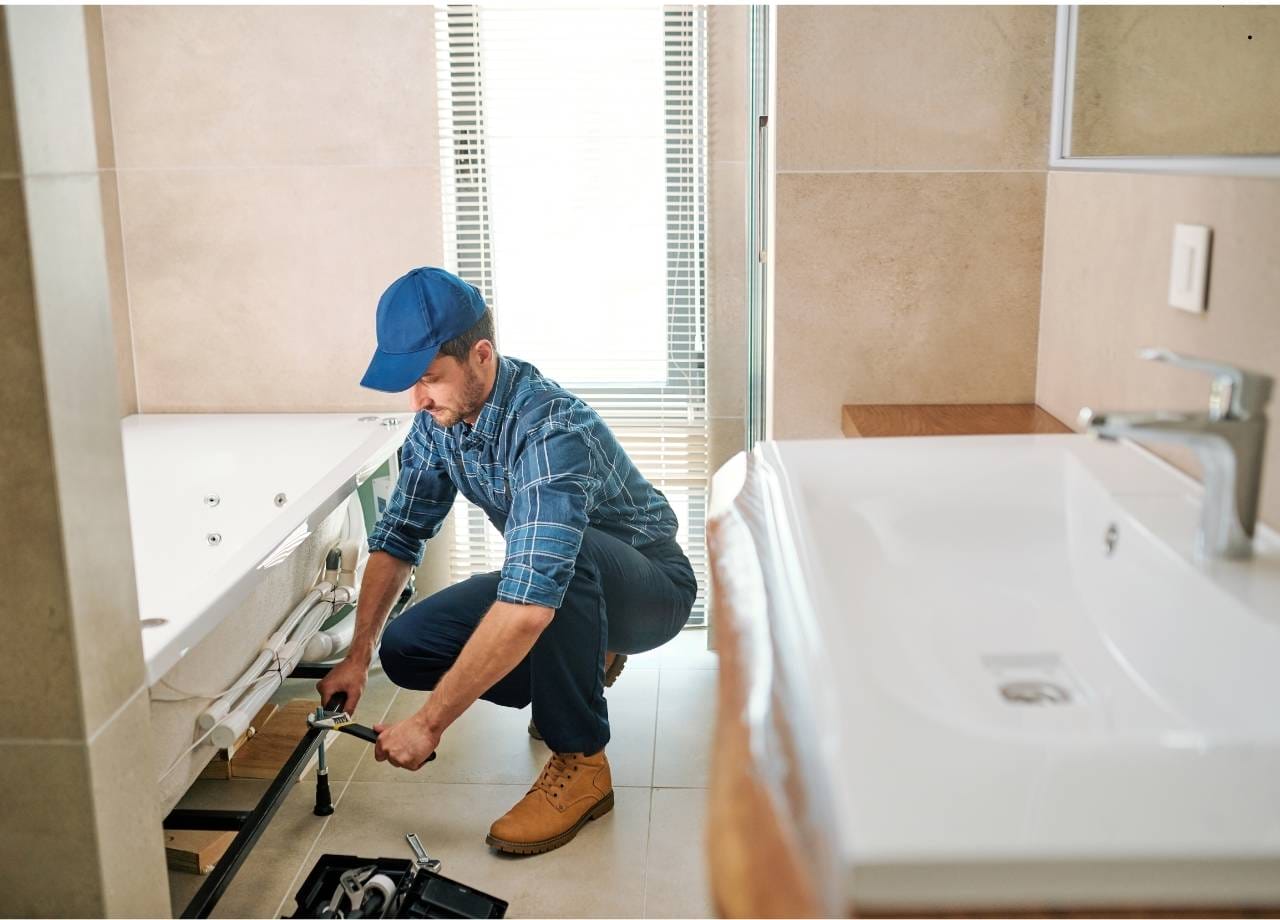Remodeling a bathroom can boost home value, improve daily comfort, and help reduce long-term maintenance. But homeowners are often stuck between two goals: upgrading and saving. The good news is, those goals don’t have to compete. With the right planning and a few smart decisions, it’s possible to stretch your budget without cutting corners on quality.
At First Coast Contracting, we help homeowners in Jacksonville, St. Augustine, and nearby areas find practical, lasting solutions that don’t break the bank. Whether you’re tackling water damage, expanding a small bathroom, or updating outdated finishes, here are seven reliable ways to upgrade your bathroom while keeping spending in check.
Table of Contents
1. Prioritize Structural and Plumbing Changes Carefully
One of the fastest ways to increase remodeling costs is moving plumbing and structural elements around unnecessarily. Relocating a toilet, shower, or tub involves rerouting plumbing lines—especially the drain stack—and possibly opening up floors or walls. That adds time, labor, and material expenses.
If your current layout works reasonably well, try to keep key fixtures in place. Focus on improving functionality through fixture upgrades, better storage, or improved lighting instead. If you’re dealing with water damage or code violations, moving plumbing may be unavoidable, but always review layout changes with a licensed contractor before finalizing any plans. In many cases, minor adjustments can achieve your goals without full-scale rerouting.
2. Go Custom Only Where It Counts
Custom vanities, walk-in showers, or built-ins can create a high-end look, but they also come with high-end prices. Instead, identify where customization adds real value and where it can be skipped.
Prefabricated vanities, for instance, are widely available in sizes that fit most bathrooms and come in modern styles with soft-close drawers, stone tops, and durable finishes. Pair one with upgraded hardware and a stylish faucet, and it can pass for a more expensive piece. Save custom work for areas where it’s truly needed—like a non-standard layout or when adding accessibility features like a roll-in shower.

A mix of stock and custom elements can help control costs without sacrificing the look or performance of your space.
3. Don’t Underestimate the Impact of Surfaces
Tile selection can make or break your budget. Natural stone and handmade tiles look great but often come with high material and installation costs. They’re also more maintenance-heavy over time.
Consider using higher-end tile in smaller focal areas—like a vertical shower accent strip or a niche—and more affordable porcelain or ceramic elsewhere. Porcelain tile, in particular, is durable, moisture-resistant, and available in a wide range of styles, including realistic wood and marble looks.
Large-format tiles can also reduce labor costs. Fewer grout lines mean faster installation and easier cleaning, especially in shower areas. You can still achieve a designer look with thoughtful patterns and color choices, even on a moderate budget.
4. Refresh Instead of Replacing Where Possible
Full tear-outs are often unnecessary, especially when the core structure is still sound. Refinishing existing elements can significantly reduce labor and material expenses.
Refinishing a tub, for instance, costs a fraction of a full replacement and can make it look brand new. The same goes for reglazing ceramic tile, particularly if it’s in good condition but an outdated color.
Cabinets with solid bones can also be refreshed with paint, new doors, or upgraded hardware. You get a similar visual impact as a full replacement, without the added demolition or custom carpentry cost. Always ask your contractor to evaluate what can be salvaged before committing to a full gut.
5. Invest in the Right Fixtures and Hardware
Saving money doesn’t mean cutting corners on the things you use daily. Cheap faucets, valves, and shower systems might look fine out of the box but often wear out faster and are more likely to leak or break down.
Instead of opting for the lowest-cost options, look for mid-range fixtures with solid brass construction, ceramic disc cartridges, and established brand warranties. These products tend to offer better reliability without premium prices.
Upgrading shower valves and mixing systems during a remodel is also a smart move. It may not be visible once the wall is closed, but modern valves offer better temperature control and easier servicing down the road. Spending wisely on hidden elements can prevent future issues and save you from repeat repairs.
6. Use Lighting to Make the Whole Space Work Better
Many older bathrooms rely on a single ceiling fixture that leaves shadows and makes grooming or cleaning harder. Adding layered lighting can completely change the way the room feels and functions—often without a huge investment.
Start with well-placed task lighting around mirrors and sinks. Wall-mounted sconces or vertical lights on either side of a mirror reduce facial shadows and make tasks like shaving or makeup application easier. Recessed ceiling lights can improve overall illumination, and dimmers allow for flexible lighting depending on the time of day.

Upgrading to energy-efficient LEDs also reduces electricity use and maintenance, which adds long-term savings to your initial investment.
7. Plan Every Step Before You Start
One of the most common reasons bathroom remodels go over budget is mid-project changes. Every switch—whether it’s a new tile choice or moving a light—can trigger extra work, material waste, and delays.
A clear, complete plan from the beginning reduces uncertainty and helps your contractor keep the project on schedule and within budget. That includes having all materials—tile, fixtures, hardware, lighting, etc.—on site before demolition begins. It’s also smart to build a small contingency (about 10–15%) into your budget for surprises behind the walls, especially in older homes.
Choosing a contractor who communicates clearly, helps you value-engineer design decisions, and understands how to navigate material availability is crucial. A remodel that’s well-planned from day one is far less likely to hit costly detours.
Final Thoughts
Saving money on a bathroom remodel doesn’t mean cutting back on function or style. It means making smart decisions—focusing your budget on the areas that matter most, avoiding unnecessary changes, and blending quality with practicality.
First Coast Contracting works with homeowners throughout Northeast Florida to develop remodeling plans that meet their needs and stick to their budgets. Whether you’re updating a dated bathroom or rebuilding after damage, we’ll help you make choices that add value, comfort, and longevity to your home.
If you’re planning a remodel and want expert advice on how to get more out of your budget, we’re ready to help.




